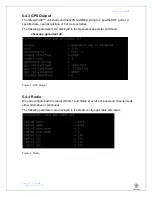
RSU2 User Guide
Savari Inc., Confidential
Copyright © Savari, Inc, 2017
RTCM
NTP
However, radio configuration between the above-mentioned applications should be consistent.
You can operate multiple StreetWAVE™ units in a hub-and-spoke configuration in which the
hub unit originates a message. It broadcasts those messages on its configured DSRC interface
to OBUs as well as on Ethernet interface to the spoke StreetWAVE™ units in Savari ’s
proprietary format. The spoke StreetWAVE™ units receive them and broadcast them on their
DSRC interfaces, essentially working as DSRC repeaters. This configuration is useful at an
intersection where no specific location has line of sight to all approaches to the intersection.
The Hub unit does not have to be in the traffic controller cabinet. It can be one of the units on
the pole if it has Ethernet connectivity to the cabinet.
4.2
IPv4 and IPv6 Networking
Each StreetWAVE™ unit consists of one Ethernet interface (eth0). StreetWAVE™ provides
support for both IPv4 and IPv6 networking on all its interfaces (eth0, Radio 1, or Radio 2).
You can enable the following on all the three available interfaces:
IPv4 and IPv6 addresses
IPv6
Router
Advertisements
StreetWAVE™ can forward both IPv4 and IPv6 packets between its interfaces (Ethernet and
DSRC) acting as a router. It also supports both IPv4 and IPv6 firewalls allowing the following:
Source and destination IPv4 or IPv6 addresses
Port-based
rules
4.3 Immediate
Forward
StreetWAVE™ Immediate Forward application supports the forwarding feature in addition to the
following features.
UDP Listener
4.3.1
StreetWAVE™ Immediate Forward application listens on configured UDP ports. If any message
is received on these ports in the format specified in
USDOT RSE requirements,
it will sign the
message using the 1609.2 protocol, if specified in the incoming message, and immediately
transmits on the configured DSRC interface with the PSID and channel specified in the
incoming message. Incoming messages could specify different priorities but it must specify the
same transmit mode (TxMode) and transmit channel (TxChannel). This feature is used when an













































